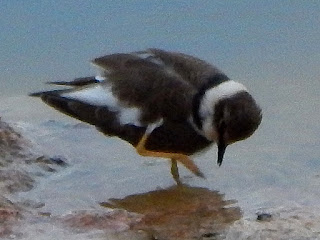With British Summertime now over I blagged a lift over to Blatherwycke Lake for the first time in ages with a view to walking back to the village here in Corby. Last time I was here in the Spring an Osprey surprised me, passing as it did before my gear had left the bag. Today it was the turn of seven Whooper Swans, four adults and three immatures which took off and headed SE, but at least I had my bins to hand if not my camera. I think that these may be my first self found Whoops in Northants for longer than I care to remember so they went down very well indeed.
 |
| Blatherwycke Lake, home of the Mandarins. |
Swans aside there was a reasonable selection of the usual wildfowl which included at least half a dozen Mandarins, this is the go to site for this species in Northants. Up to four Little Egrets were in the general area and these included two that really seemed to hate each other as both went to great lengths to have a fight. Three Black Swans were swimming amongst the many Mutes, there always seems to be Blacks in this area and on the subject of dodgy wildfowl one of the Chinese Geese was honking very loudly.
 |
| Weird and wonderful. |
When I'm in this neck of the woods I always like to have a peek over the fence of a property which has a varying collection of exotic fauna. On this occasion I could only see one Red-necked Wallaby and no Rheas, I hope that the animals have been sold on and have not expired but please under no circumstances mention the prospect of dierhea. What was a surprise here though was at least two Capybaras, they look like furry Pygmy Hippos! This place always adds a much needed injection of weird into my day and long may it continue. I'm not given to counting stuff as a rule but a flock of forty one Collared Doves in the village was noteworthy.
 |
| Two of three Whoopers near Bulwick. |
Walking on towards Bulwick I was saddened to find my first Hedgehog of the year, a fresh road casualty, it's sad when you consider how rare they've become. This and several equally dead rabbits may help to explain the number of kites in the area, at least fifty between Blatherwycke and Deene with rather a lot of Buzzards keeping them company. Approaching Bulwick I saw three swans flying towards me, I thought that they may be Mutes commuting between Deene and Blatherwycke lakes but a sudden bout of calling revealed them to be more Whoopers. Dodgy record shots taken as they headed in a similar direction to the previous birds. On the outskirts of the village a trio of Fieldfares were my first of the Autumn.
 |
| G'day cobber. |
A Redpoll passed over as I reached Deene Lake while on the main water a selection of the commoner ducks included Shoveller. The two Egyptian Geese from my previous visit were still here and so too were the Black Swans, I don't know if this little part of Northants resembles Australia but they seem to like it here. The inflow had two Green Sands and a Snipe at the WBT where a Grey Wagtail was also seen. Plenty of Teal in the area but despite much checking no Green-wingeds.
 |
| WBT waders, Green Sand and Snipe. |
Deenethorpe village had Siskins mixed in with the Goldfinches but I didn't hang around long here. The nearby airfield was alive with many of the open country species that seem so much scarcer than they used to be. Plenty of Skylarks and Meadow Pipits were joined by Yellowhammers and Linnets. A female Stonechat was again present, she seems to be fond of a bramble from which to sally forth in search of bugs. Another Redpoll passed over and a couple of Lapwings were observed.
 |
| Shaggy Ink Cap fungus and Stonechat. |
The public footpath that runs from the A427 to Bears Lane yielded more Lapwings, at least fifty, which were feeding with a large flock of Starlings. Plenty of gulls, the five commoner species were found in the area, I searched through them but couldn't find a Med. Sheltered spots along the hedgerows proved to be attractive to Common Darters, at least five were active. Strange to have Whooper Swans and dragonflies in the same post but that's nature for you. A quick look in Laundimer Wood produced more Siskins but little else.
 |
| Yes I know I've included them a lot recently but it could be ages before we see any more Admirals or Darters. |
I finished my day in the Weldon area where six or seven Red Admirals were seen which included at least three feeding on the fast disappearing Ivy flowers. A hawker sp was glimpsed and was likely to have been a Migrant but I can't be sure, either way it had been a jolly good day.



















































